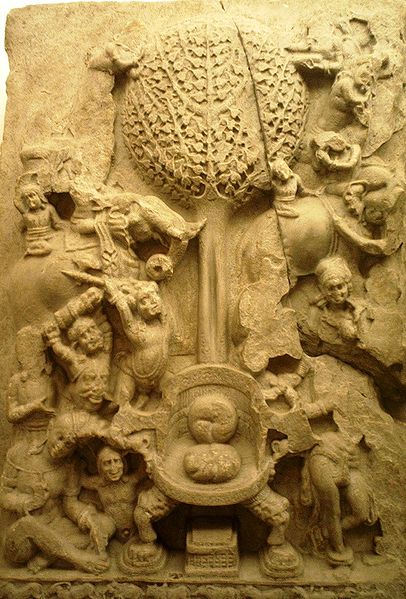Aniconism is the cultural absence of artistic representations (icons) of the natural and supernatural worlds, or it is the absence of representations of certain figures in religions. The prohibition of material representations may only extend to a specific supreme deity, or it can encompass an entire pantheon, it can also include depictions of a prophet, saints, or sages, or even depictions of living beings and anything in existence generally. It is generally codified by religious traditions and as such, it becomes a taboo. When it is enforced by the physical destruction of images, aniconism becomes iconoclasm.
An aniconic representation of Mara's assault on the Buddha, 2nd century CE, Amaravati, India.
Traditional flower offering to the aniconic Shiva linga in Varanasi
Persian miniature painting from the 16th century AD, depicting Muhammad, his face veiled, ascending on the Buraq into the Heavens, a journey known as the Mi'raj.
Detail of Dayenu in the Birds' Head Haggadah
Since the beginning of the serious study of the history of Buddhist art in the 1890s, the earliest phase, lasting until the 1st century CE, has been described as aniconic; the Buddha was only represented through symbols such as an empty throne, Bodhi tree, a riderless horse with a parasol floating above an empty space, Buddha's footprints, and the dharma wheel.
Aniconism in Miracle at Kapilavastu: King Suddhodana praying as his son the Buddha rises in the air, praised by celestial beings (but only the Buddha's path, the Chankrama horizontal slab in the air, is visible).
Pillar with Naga Mucalinda protecting the throne of the Buddha. Railing pillar from Jagannath Tekri, Pauni (Bhandara District). 2nd–1st century BCE. National Museum of India.
An aniconic representation of Mara's assault on the Buddha, with an empty throne, 2nd century, Amaravati, India.
Devotions to the empty throne of the Buddha, Kanaganahalli, 1st–3rd century CE







